When it comes to integration with GRID, they do not provide good performance when it comes to reducing the peak in GRID. This is because many companies experience the maximum system demand during the cool summer months. This happens between 2:00 pm and 6:00 pm or 7:00 pm. In some western rural areas Cirro Energy , it may take longer.
The reason these south-facing systems only offer peak system reduction is that they are all at peak activity from 11 am to 2 pm in the afternoon. (The situation varies from some) After that, their production usually drops to 50% of their nominal level. For example – a 5 KW south-facing system that is above the line with all the right components, etc will produce around 4.4 or 4.6kw during the day. It is a good product and it helps if the electricity is exported from the grid. On the other hand, if the customer uses their electric load at the moment and consumes the solar energy itself, this will reduce the demand for the GRID. But in the period from 2 pm to 6 pm, the solar output decreases. These measured studies of solar units often show about a 50% loss or reduction in capacity and output. Therefore, a system will produce 2.5 KW plus or minus some variance.

For these purposes, electric companies that have investigated the charging of solar systems facing south will allocate a 40% to 50% load capacity value to the solar system. This is important as they do the cost of assigning services to the level of demand etc. Utilities are also trying to develop some kind of future solar and GRID cost analysis. Solar advocates are advocating for greater recognition of benefits, but sometimes they don’t understand the partial benefits of the GRID concept.
A new way to overcome the limitations of a south-facing solar system is to install a hybrid system. Using 5 kW as total power – the new way is to keep 2.5 kW facing south and put the remaining 2.5 kW facing WEST. These systems will produce a few Kwhr in total (about 650 per year in Southwest Texas based on computer simulations), but during the summer months, the West-facing sides receive more sun. for a long time. the length of the day. It can work as early as 7:30 am or even 8 am in west Texas, through western Arizona. As a result, these units provide higher generation than their capacity during the daytime peak. This benefits the network more than just the south. These systems can achieve an effective load capacity of 70-80%.
The Arizona study shows a 66% reduction in energy consumption, which is impressive and useful. They reduce the peak over the southern orientation, so they help the grid, correcting the issue of lost revenue for the company. Public utility companies can use these types of strategies to differentiate between a solar user on the GRID and a non-solar user, etc. These measures can reduce the cost of capital and the need for ownership of equipment. The savings in generation, transmission, and some distribution costs will make the sun more useful in the road and add energy near-carrying without major line losses, with all the positive environmental benefits and economic development and the utility of this on a solar tower. community providing agency.
The customer type of solar offers benefits to the GRID, so the distribution of costs for this type of customer will be smaller and they can benefit from a good electricity tariff. Now, this is fulfilling the idea further and faster than the forces that seem familiar, so it is not far apart from the pilot study.
The energy compromise between all South exposure and 50 to 50 South/West exposure is a loss of approximately 660 Kwhr of total production over the entire year. Using the SW model of electricity provides an electric utility of 0.13 cents per kWh increased by 660 lost generations resulting in net savings of $85.80 on an annual basis.

